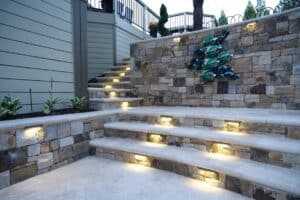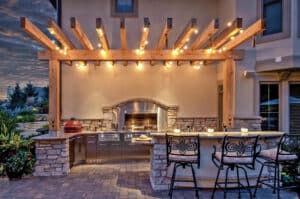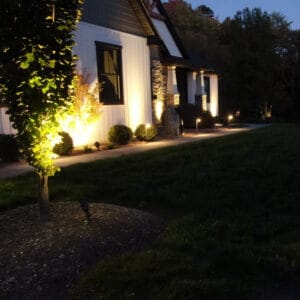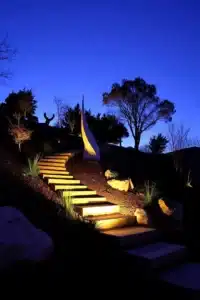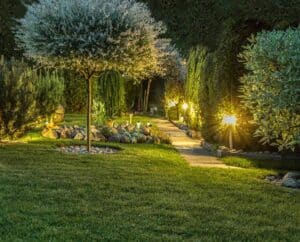Does your garden disappear when the sun goes down? For many homeowners, outdoor lighting is purely functional—a few path lights to avoid tripping and a porch light to find the keys. But what if your lighting could do more? What if it could turn your garden into a living sculpture, a breathtaking masterpiece that comes alive after dark?
You don’t just own a yard; you have a canvas. Using light as your brush, you can paint a scene that’s dramatic, serene, or utterly magical. This guide to artistic landscape lighting will show you how. We’ll move beyond the basics and show you how to plan your own landscape lighting design that adds depth, mystery, and beauty to your outdoor living space.

The Language of Light: Understanding the Fundamentals
Before you can create a masterpiece, you need to understand your tools. In landscape lighting, your tools are the properties of light itself. Getting these right is the first step toward a professional, high-end design.
Create Layers, Not Just Light
A beautifully lit garden isn’t uniformly bright. It has layers, just like a well-designed interior. This layered approach is a principle supported by professional landscape architects for creating spaces that are both functional and beautiful.
- Ambient Light: This is the general, soft glow that provides overall illumination. A technique like “moonlighting” can create a beautiful ambient effect.
- Task Light: This is functional light for specific activities, such as illuminating steps, grilling areas, or pathways for safe passage.
- Accent Light: This is where the artistry happens. Accent lights draw the eye to specific features—a magnificent tree, a textured stone wall, or a beautiful sculpture. This is how you create drama and focus.
A successful design blends all three layers seamlessly, guiding the eye through the landscape and creating a cohesive, inviting atmosphere.
The Mood of Color Temperature
Light isn’t just white; it has a color temperature measured in Kelvin (K). A lower Kelvin number means warmer, more yellow light, while a higher number indicates cooler, blueish light. Understanding how color temperature creates mood is essential. For gardens, a warm white light (around 2700K) is almost always the best choice. It enhances the natural colors of plants and stone, creating a cozy and inviting ambiance that feels luxurious and natural, not sterile or harsh.
Your Palette: Core Artistic Landscape Lighting Techniques
Ready to start painting with light? These professional techniques are the foundation of all stunning creative outdoor lighting designs. Each creates a distinct effect and can be used to tell a different story in your garden.
Uplighting: The Power of Drama
Uplighting is exactly what it sounds like: aiming a light upward from the ground. It’s one of the most powerful ways to create a sense of drama and grandeur. By casting light onto a feature from below, you reverse the natural order of sunlight, instantly drawing attention. For those who want to achieve a truly professional look, mastering uplighting techniques is key.
- Best For: Specimen trees, architectural columns, home facades, and garden statues.
- How to Do It: Place an accent spotlight at the base of the feature. The closer the light is to the object, the more focused and dramatic the effect. Move it further away for a wider, softer wash of light.
Moonlighting: A Touch of Magic
For a more subtle and enchanting effect, try moonlighting. This involves placing a light fixture high up in a mature tree and angling it downward. The light filters through the branches and leaves, casting soft, dappled shadows on the ground below—just like natural moonlight.
- Best For: Large, open-canopy trees like maples, oaks, or pines that overlook a patio or lawn.
- How to Do It: This is a more involved technique, often requiring professional installation. For a complex job like this, it’s often best to find a Tru-Scapes Pro near you.
Silhouetting & Shadowing: Playing with Shapes
Silhouetting and shadowing are two sides of the same artistic coin. They use an object’s shape to create visual interest against a lit surface.
- Silhouetting: Light a surface behind an object. This throws the object into a dark silhouette, emphasizing its shape. It works beautifully for plants with unique, recognizable forms like Japanese maples or sculptural topiaries. Place a well light or spotlight between the plant and a wall or fence.
- Shadowing: Light an object from the front to cast its shadow onto a surface behind it. This is a fantastic way to add texture and movement to a plain wall, especially if the plant (like ornamental grass) will sway in the breeze.
Grazing: Revealing Hidden Texture
Have a beautiful stone wall, brick facade, or tree with interesting bark? Grazing is the technique to make it pop. By placing a light very close to the surface and aiming it parallel to it, you create strong highlights and deep shadows that reveal every nook and cranny. It’s a high-impact technique that adds incredible depth and a professional touch.
- Best For: Stone, brick, wood, tree bark, and other textured surfaces.
- How to Do It: Use hardscape lights tucked under the capstones of a wall, or place accent lights right at the base of a surface, aiming them almost straight up. You can explore hardscape lighting options designed specifically for this effect.
Choosing the Right Tools for Your Artistic Vision
The effect you create is entirely dependent on the fixture you choose. Low-voltage lighting systems, like those from Tru-Scapes, offer a wide range of professional-grade fixtures designed for specific artistic purposes.
| Technique | Best For | Desired Effect | Recommended Fixture Type |
| Uplighting | Specimen Trees, Architectural Features | Dramatic, Majestic | Accent Light / Spotlight |
| Moonlighting | Mature Trees with Open Canopies | Natural, Serene, Magical | Accent Light (mounted high) |
| Silhouetting | Plants with Unique Shapes, Sculptures | Mysterious, Artistic | Well Light, Spotlight |
| Grazing | Textured Surfaces (Stone, Brick, Bark) | Highlighting Texture, Dramatic | Hardscape Light, Accent Light |
| Washing | Hedges, Privacy Screens, Walls | Soft, Even Illumination | Wash Light / Flood Light |
| Path Lighting | Walkways, Flower Bed Borders | Safety, Guiding, Gentle Glow | Path Light / Area Light |
Frequently Asked Questions About Creative Outdoor Lighting
As you plan your project, a few questions naturally arise. Here are some quick answers to common queries.
What is low-voltage lighting, and why is it preferred?
For a full overview, see our comprehensive guide to low-voltage lighting. In short, these systems use a transformer to reduce standard 120-volt power to a much safer 12 volts. This makes the system significantly more energy-efficient—a fact backed by research on the proven energy-saving benefits of LED technology—much safer to work with, and allows for easier installation. It’s the standard for high-end residential landscape lighting.
How do I avoid creating “light pollution” or annoying my neighbors?
Great question! A good lighting design is about practicing responsible outdoor lighting. Use fixtures with glare shields, aim lights carefully away from windows (yours and your neighbors’), and focus on subtle effects rather than overwhelming brightness. The goal is to create ambiance, not a landing strip.
Can I mix and match different lighting techniques?
You absolutely should! The most stunning and dynamic garden lighting ideas come from using a combination of techniques. You might uplight a large tree in the back, graze a stone wall on the patio, and use soft path lights to guide the way between them. Layering creates a rich, complete, and immersive experience.
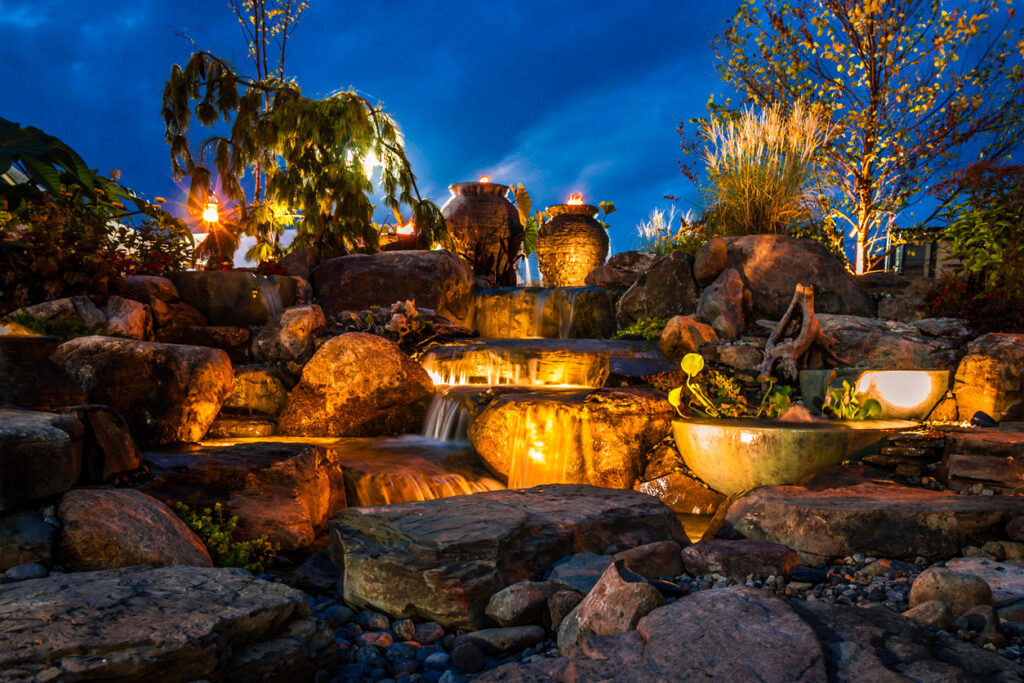
Your Garden Is Ready for Its Spotlight
Your home’s beauty shouldn’t fade with the daylight. By embracing artistic landscape lighting, you can add a whole new dimension to your property. Think beyond simple function and start seeing your garden as a canvas for light and shadow. Use uplighting to create drama, moonlighting to evoke wonder, and grazing to reveal hidden textures. By layering these techniques, you can design an outdoor space that is captivating, elegant, and uniquely yours.
Ready to transform your evenings? Explore our collections of professional-grade accent, path, and hardscape lights to find the perfect tools for your artistic vision.
What part of your garden would you love to see in a new light? Share your ideas in the comments below!



